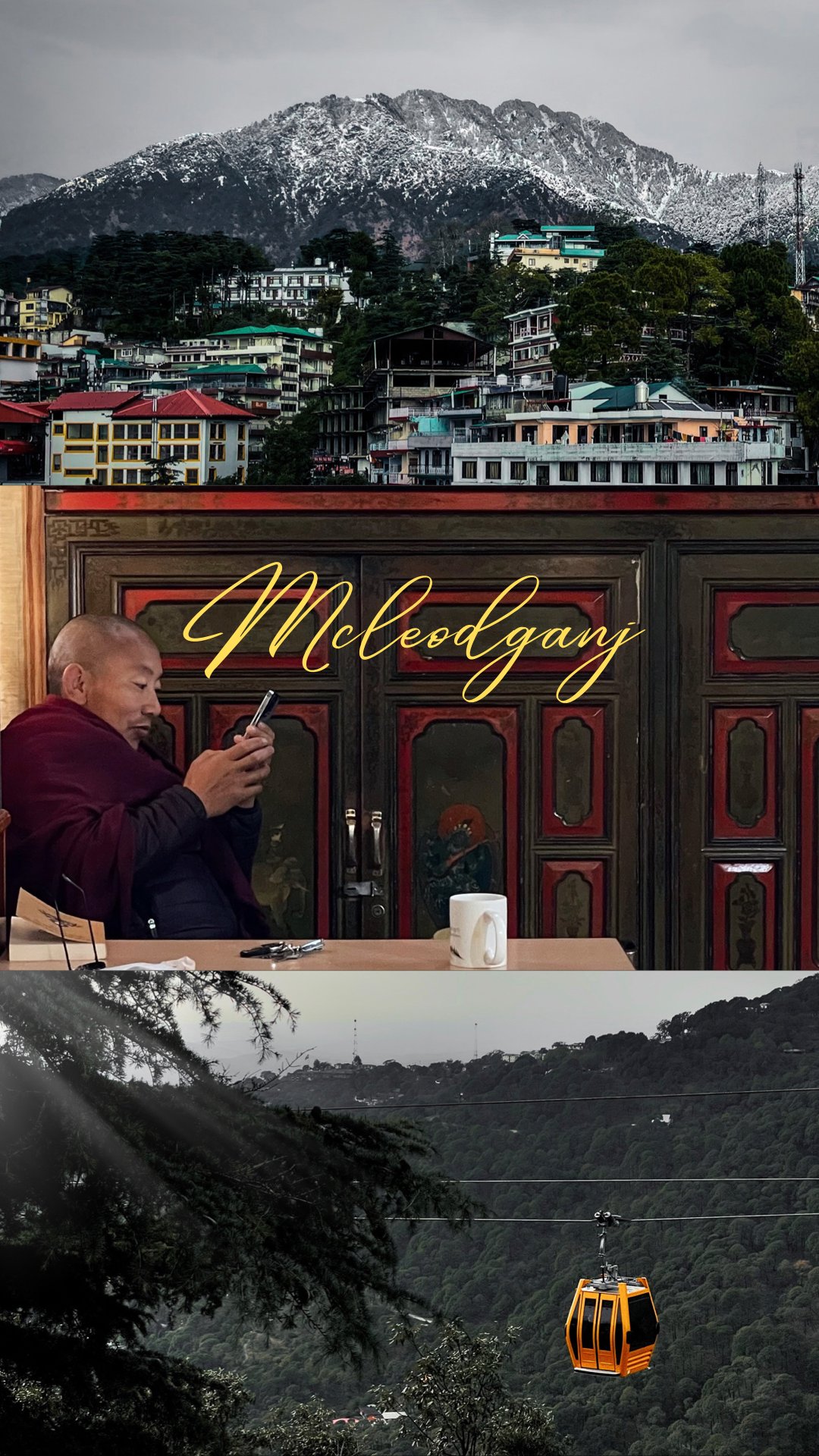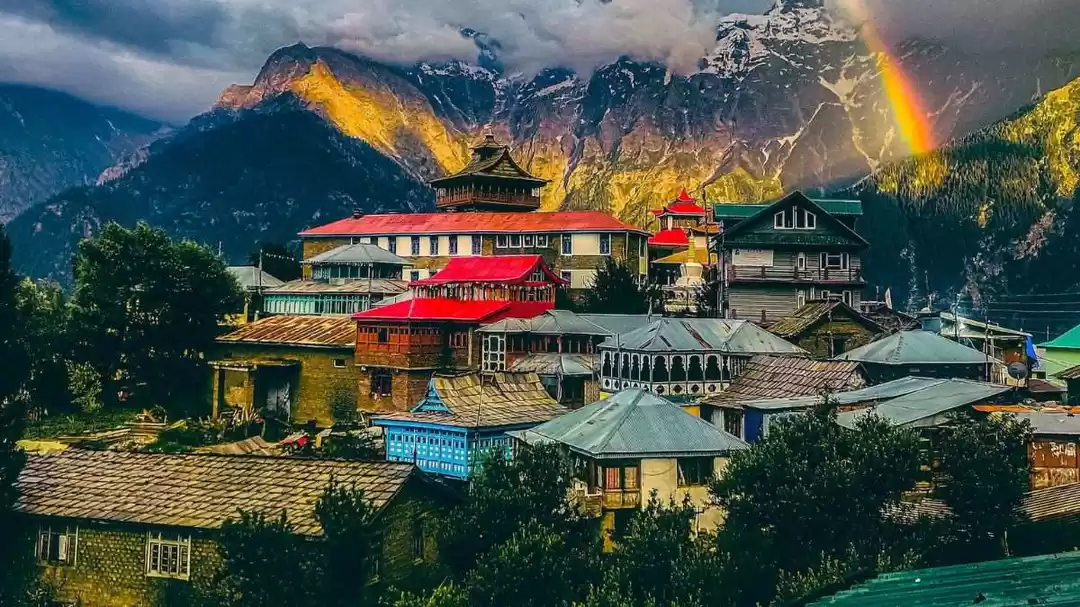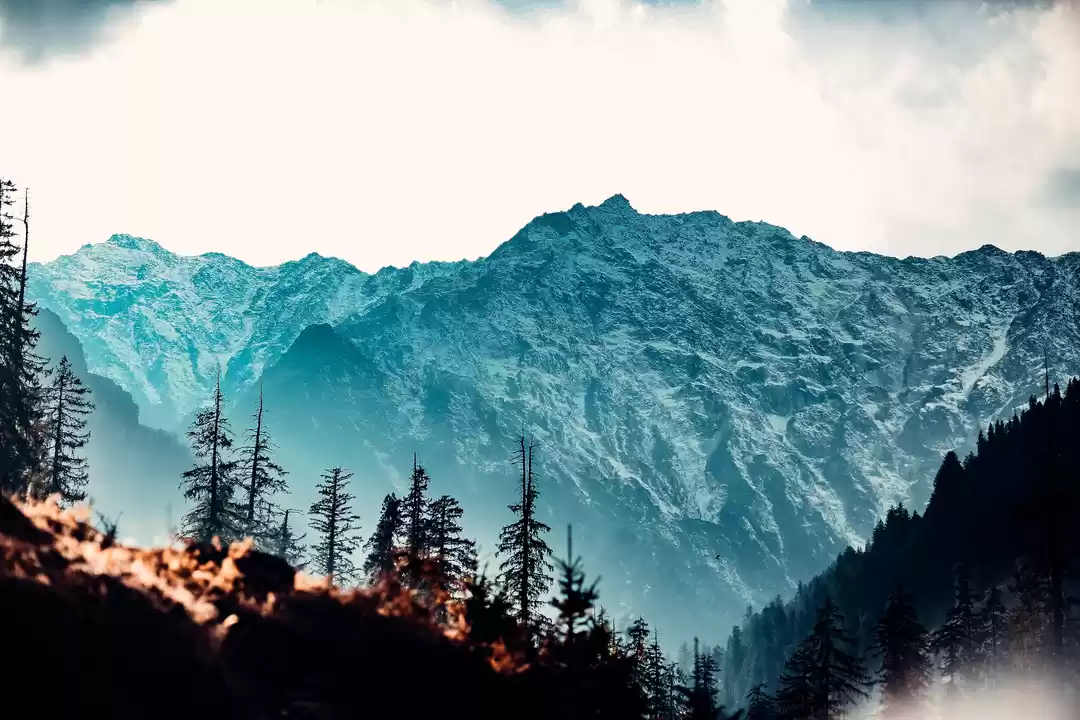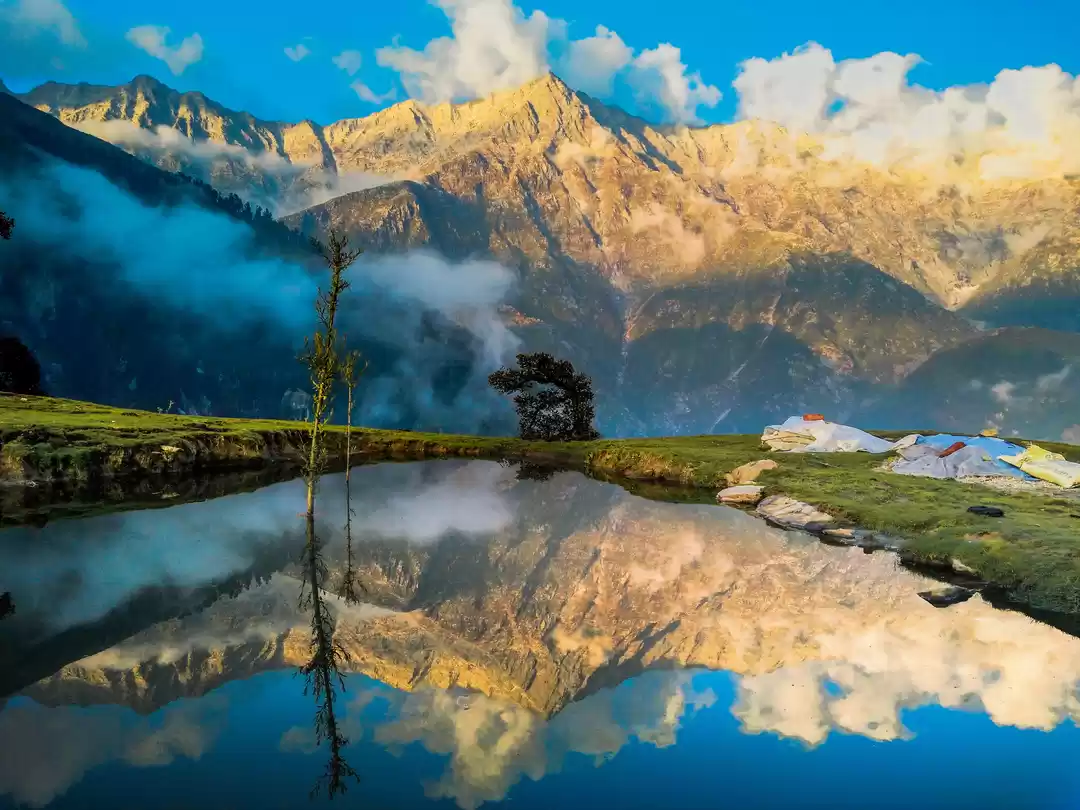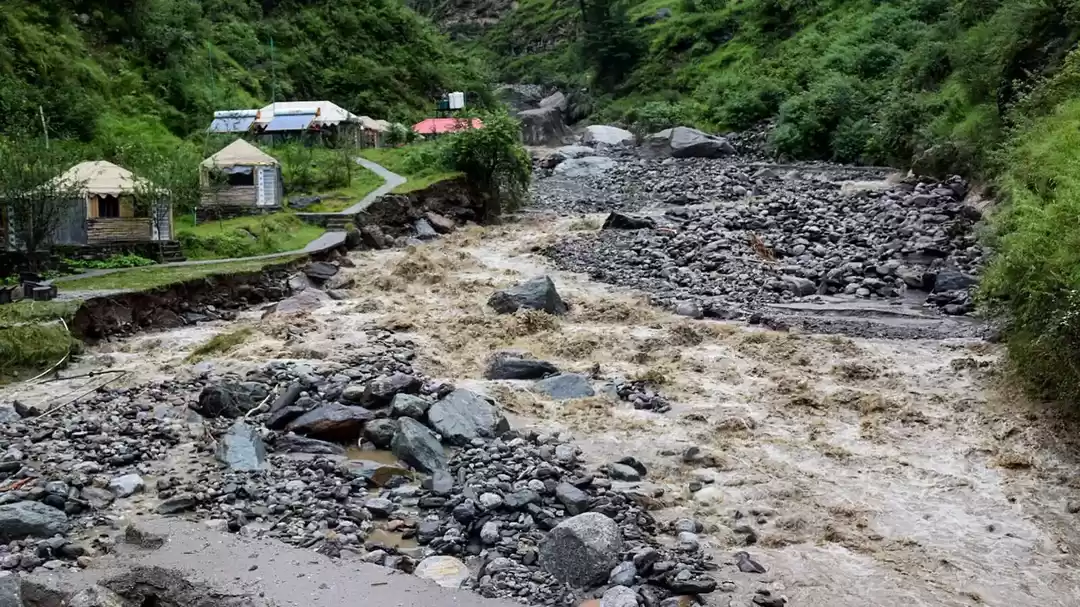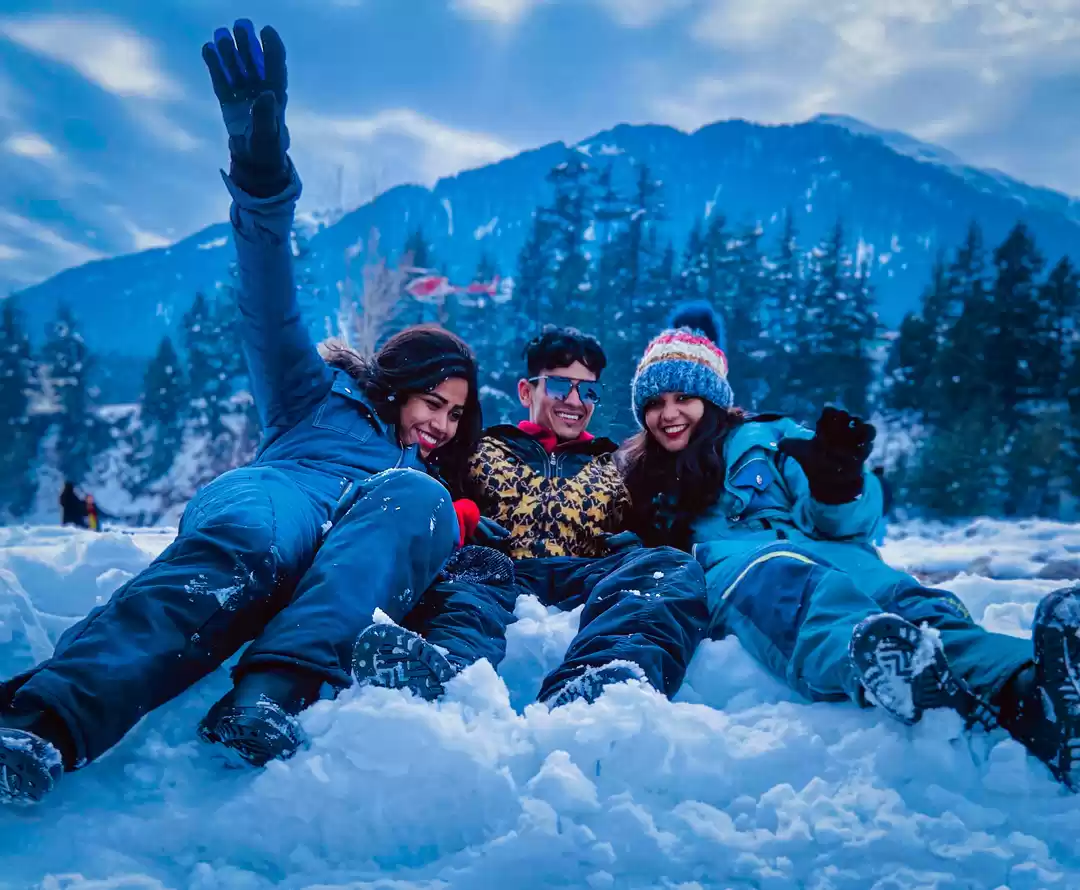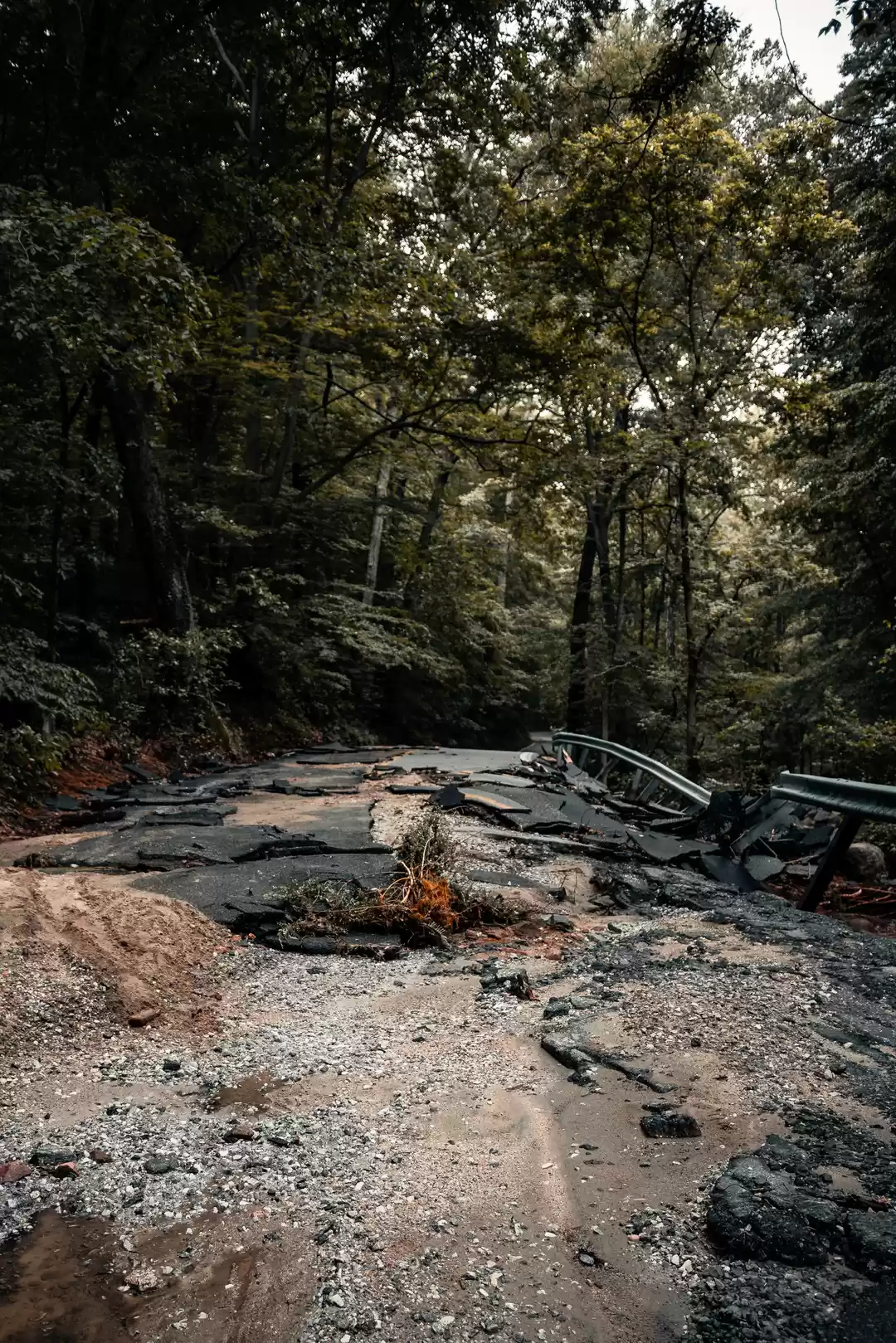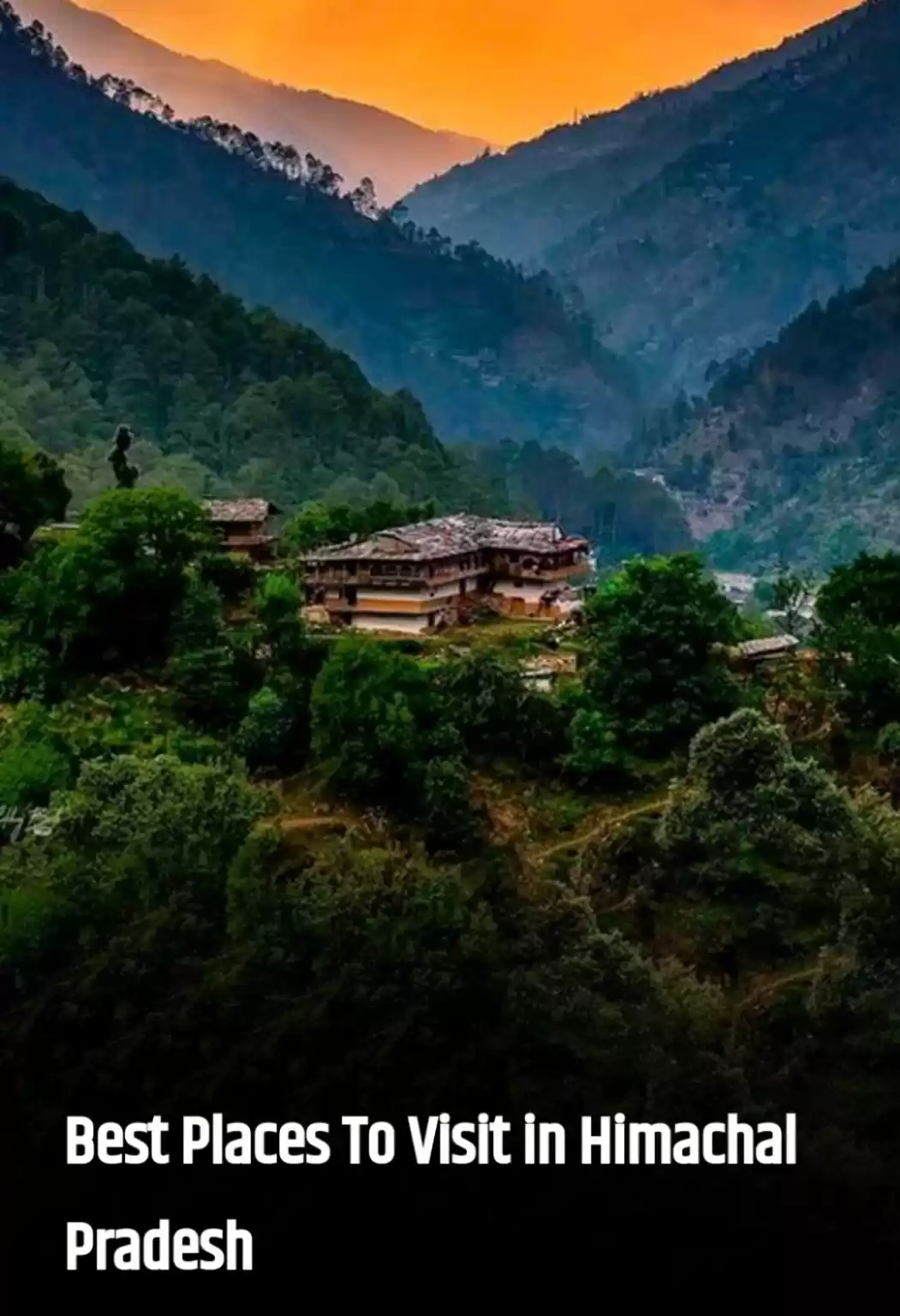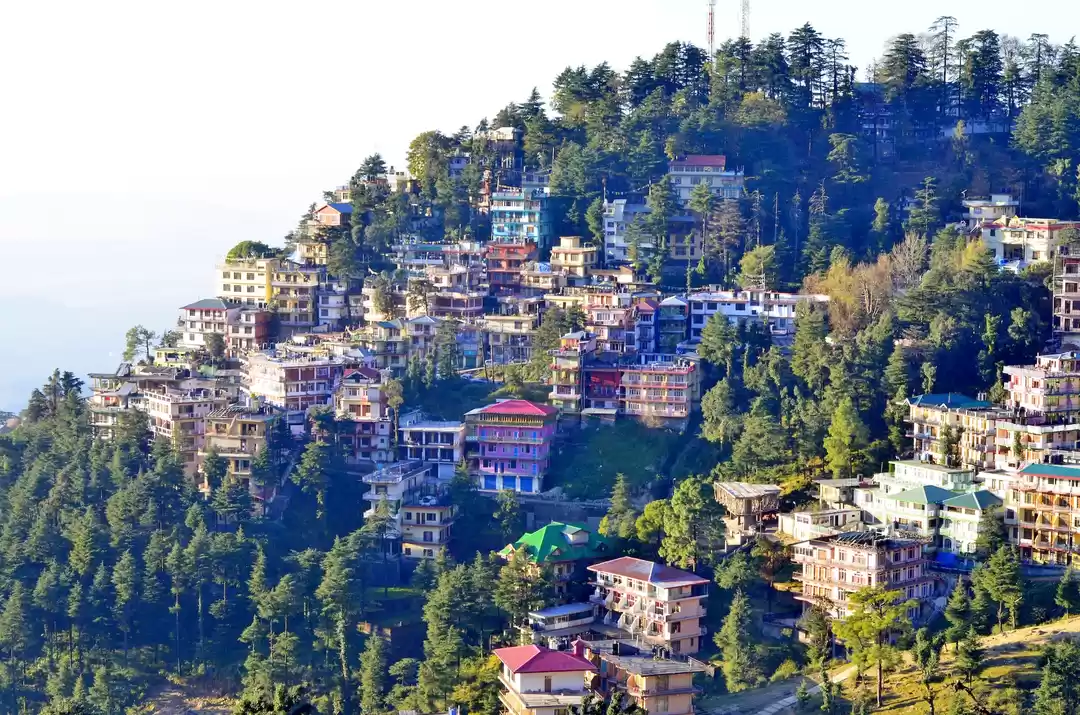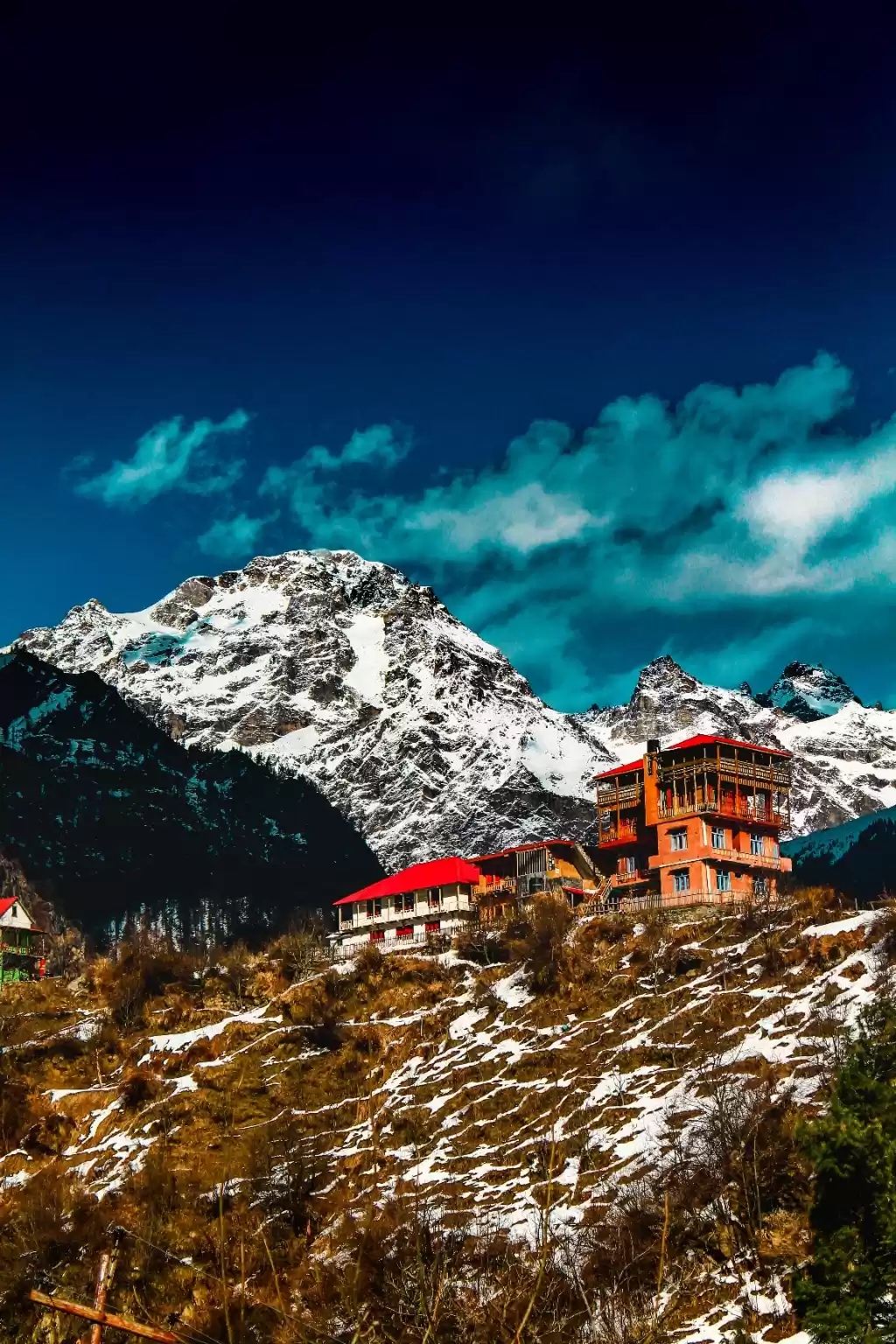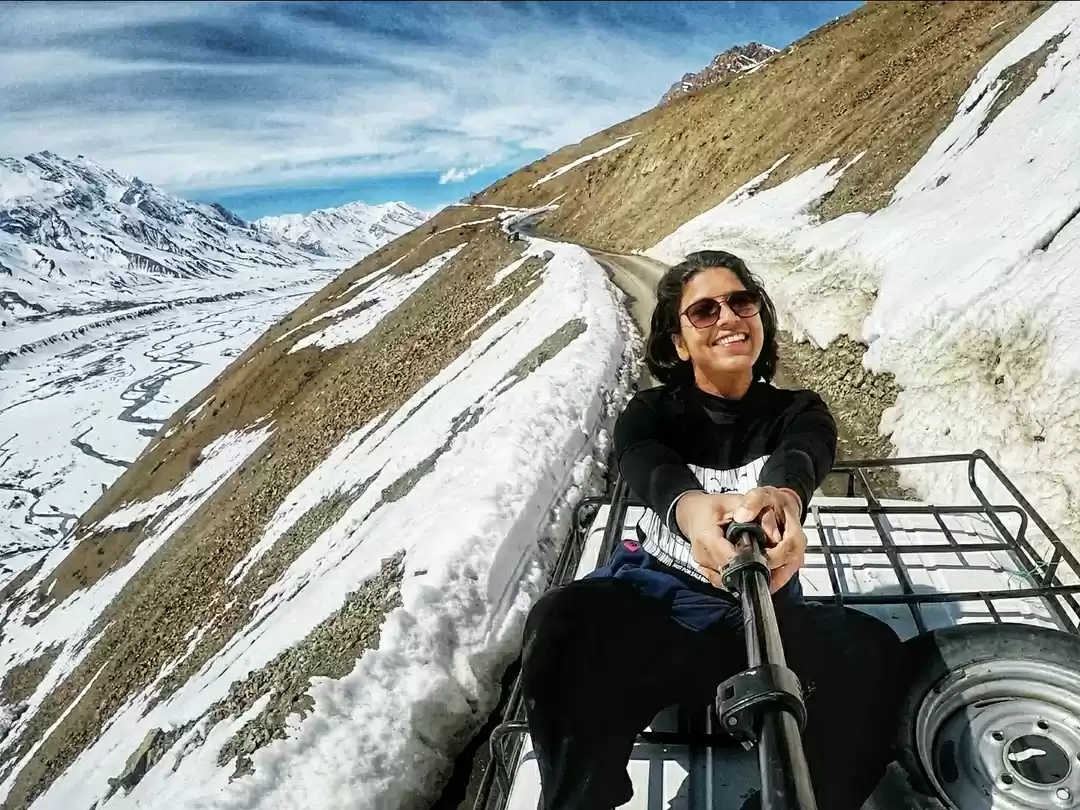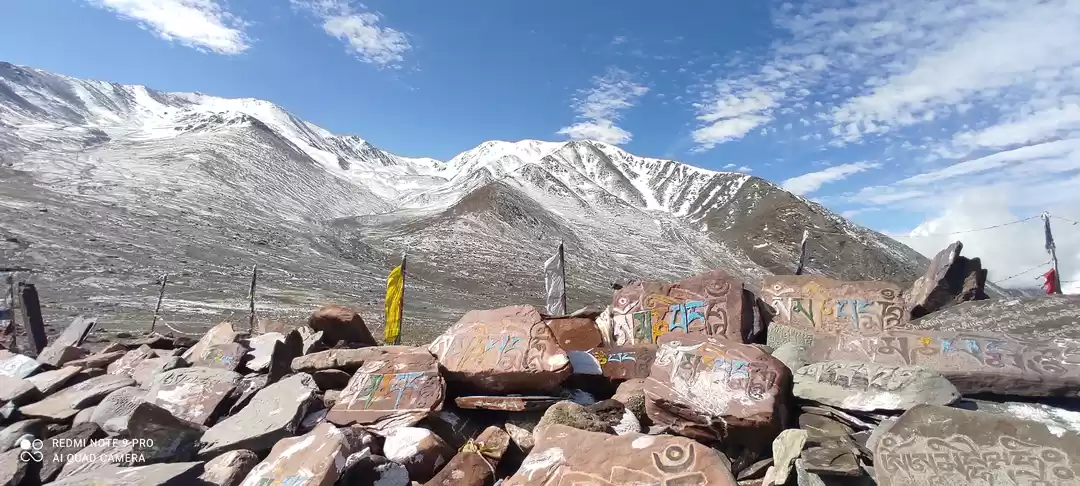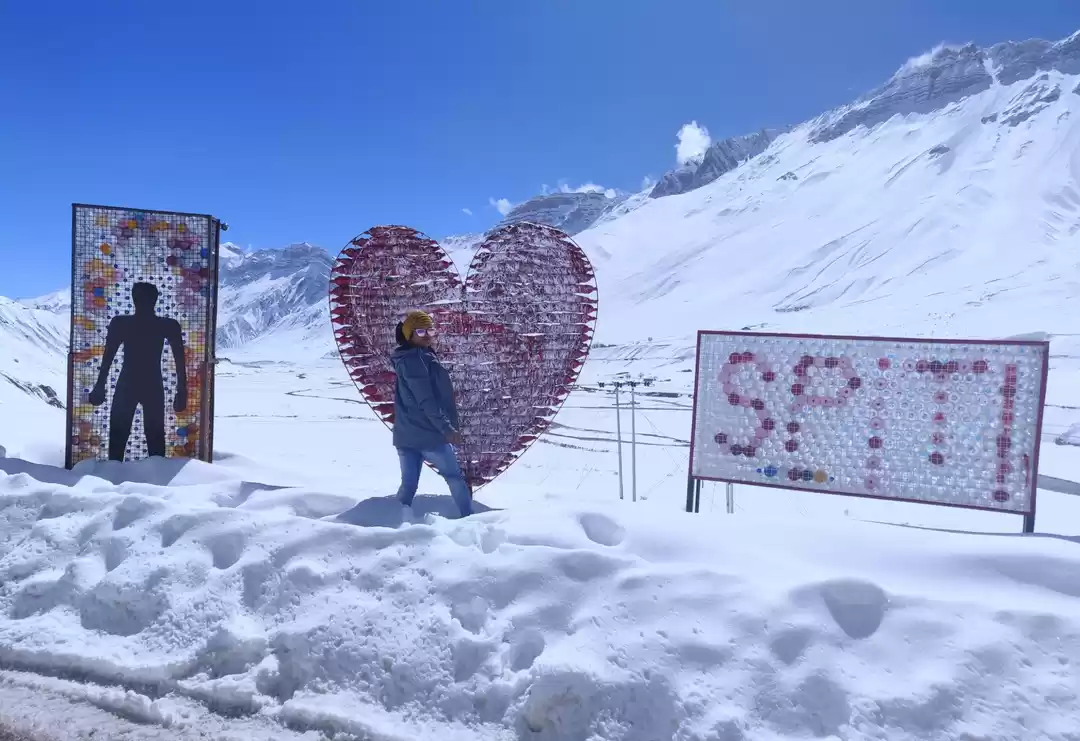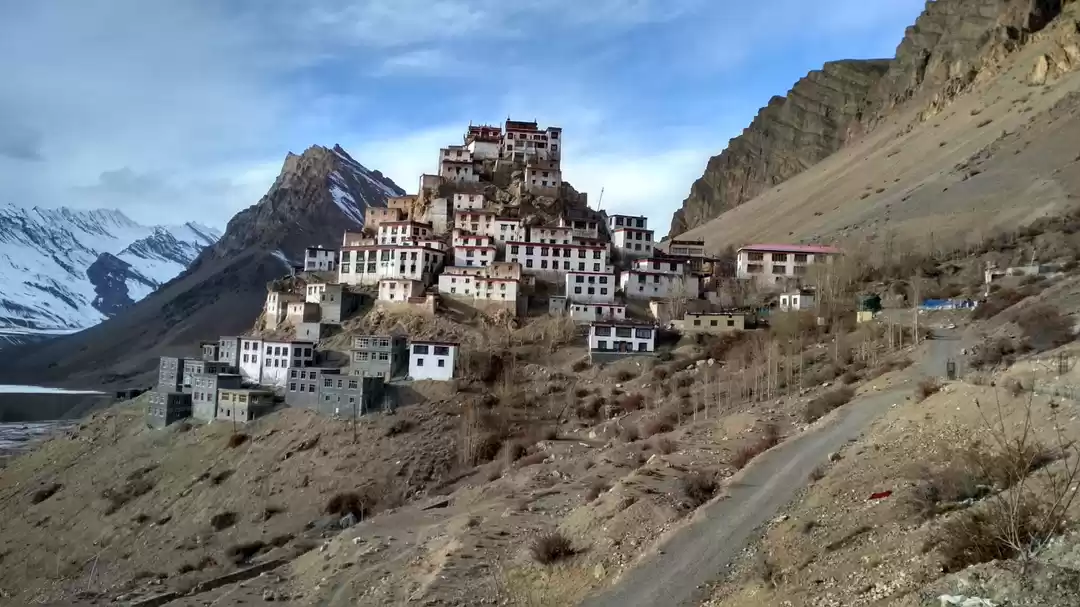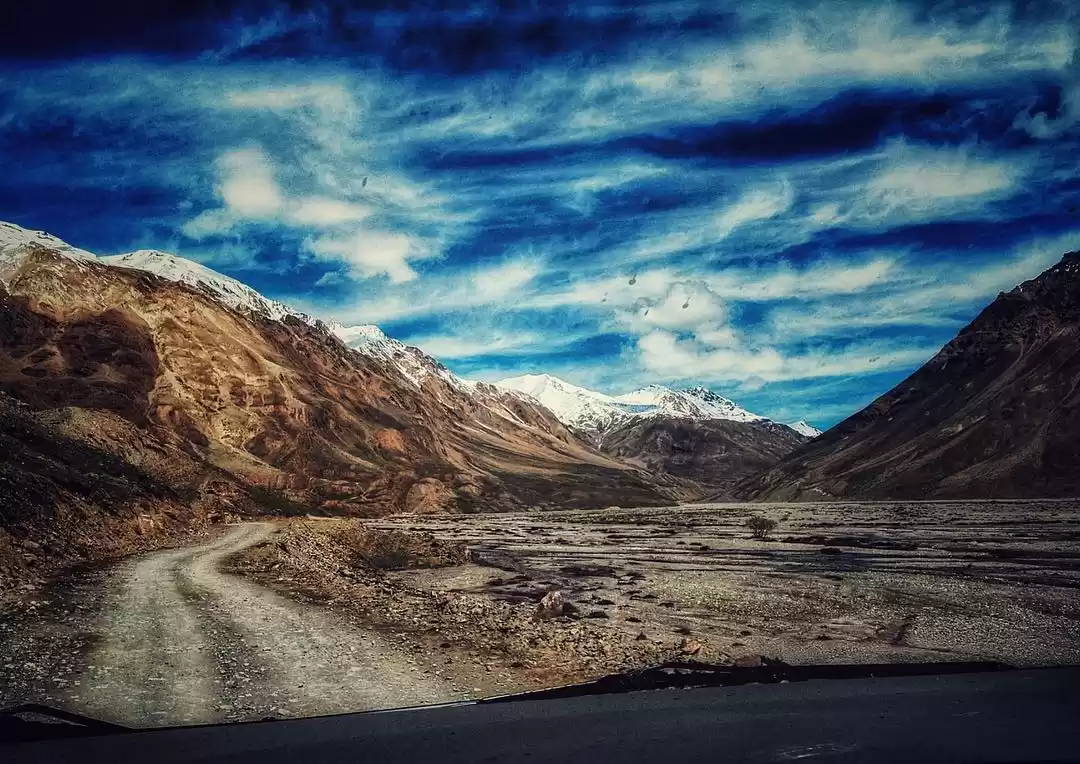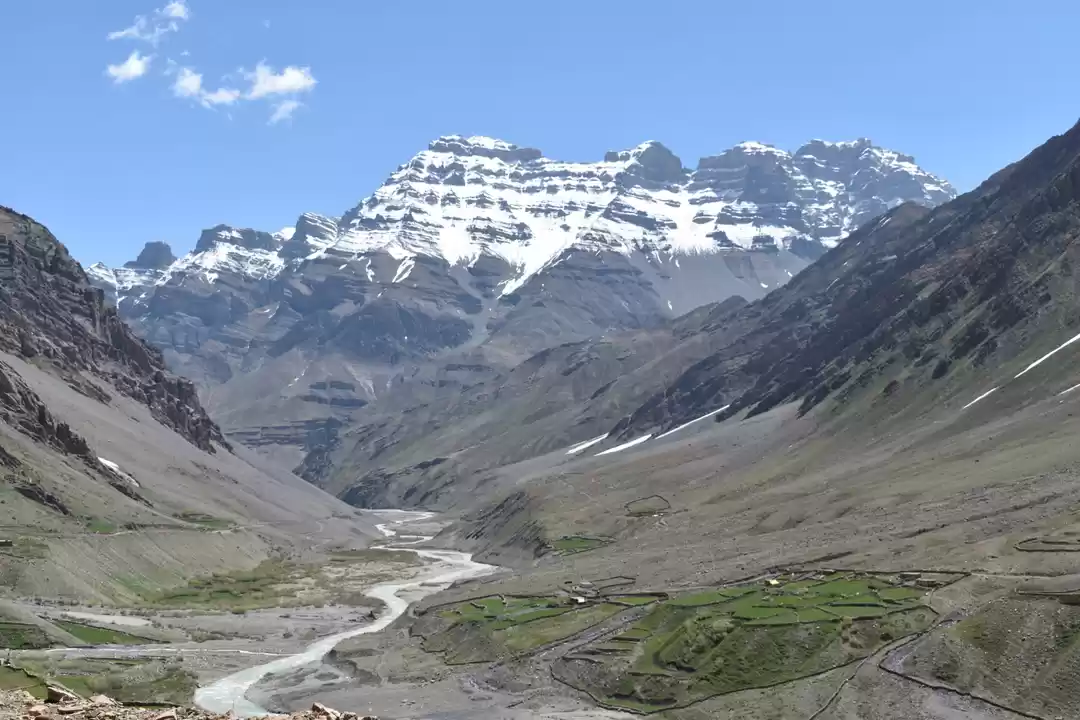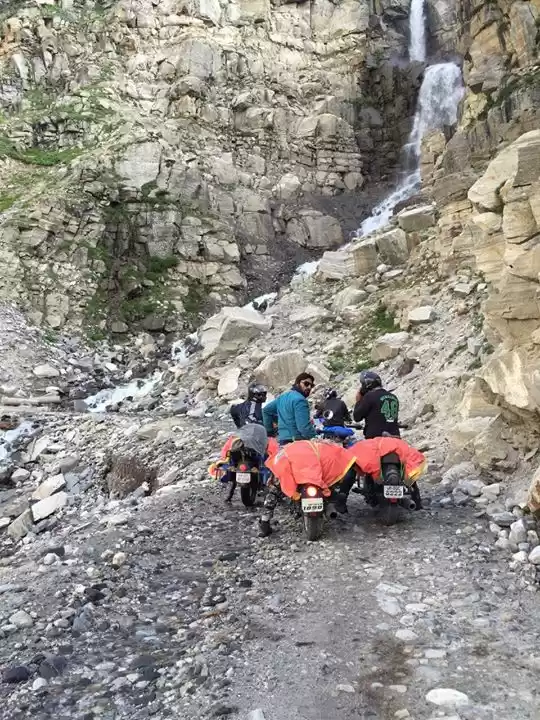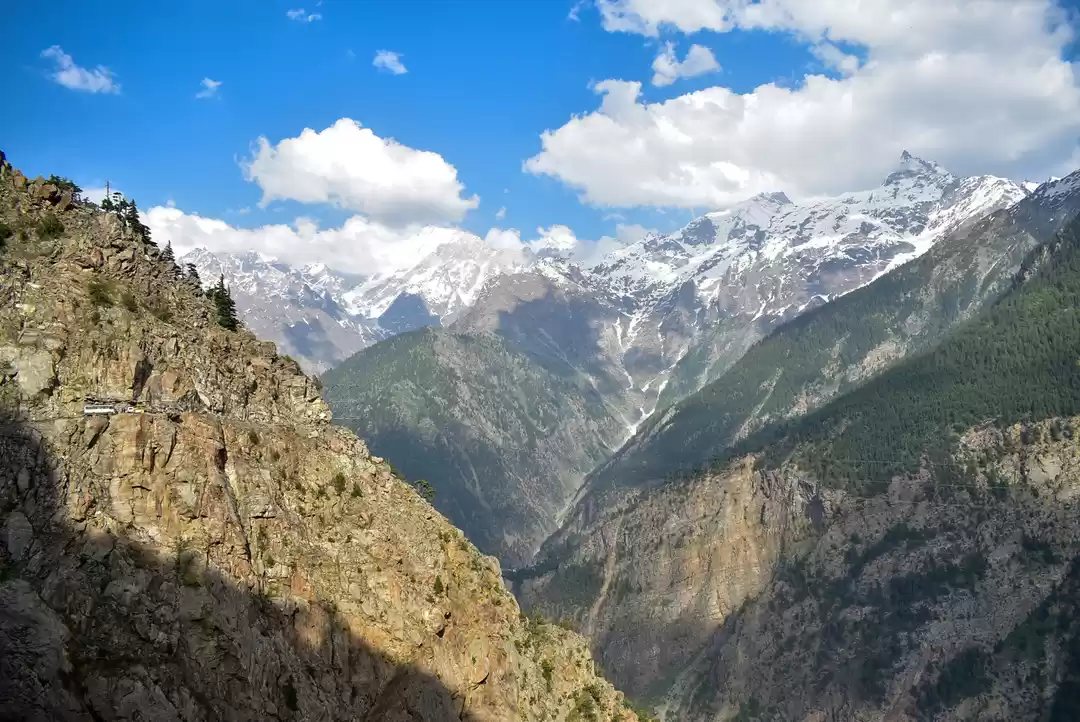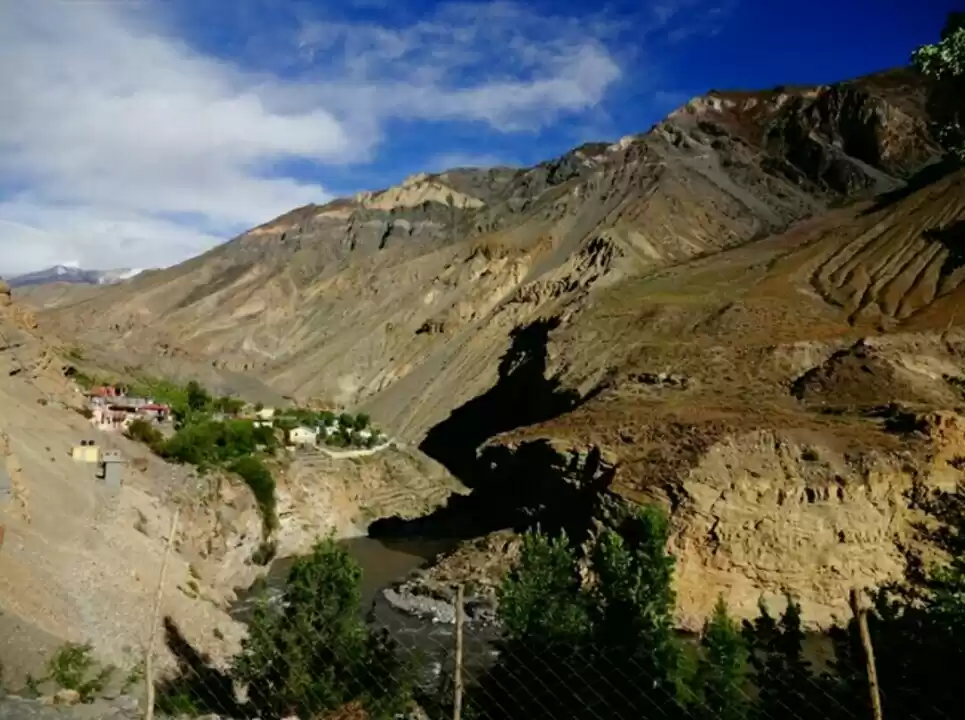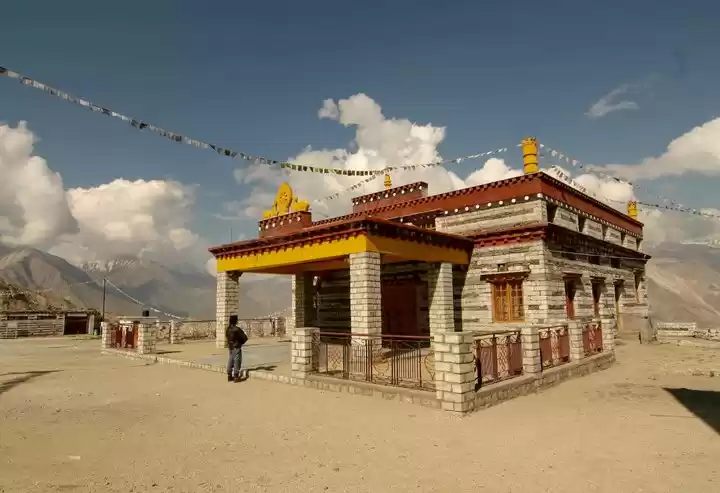
To put it in the words of Jane Wilson-Howarth, “The mountains were so wild and so stark and so very beautiful that I wanted to cry. I breathed in another wonderful moment to keep safe in my heart.”
Perched amidst the Himalayan abode, Spiti is a cold desert mountain that is formed by the rustic landscapes and exciting roadmaps that make it a perfect destination for roadtrippin’. The Spiti Valley road trip will take you through the treacherous curves and gorgeous valleys, while the meandering rivers and the high passes welcome you with open arms.
My first journey to Spiti Valley was in October 2017 and I was completely mesmerized by the beauty of nature, unfolding itself in this part of the Himalayan Region. Ever since then, I had thought of taking a trip to the valley during winter, when everything turns white – but it took me 3 years to finally tick it off my wish list.

Well, I could have definitely planned it on my own, but the journey wouldn’t have been so memorable without the bunch of amazing folks, whom I traveled with 🙂
During our week-long journey, we crossed some popular hill stations like Shimla & Sarahan, traversed across the treacherous roads with snow-clad mountains soaring high around us and crystal clear rivers accompanying throughout.
We stopped at places – sometimes, to click photographs of icicles hanging from rocks and at times, to just stretch our legs and walk around the snowfields, feeling the chills in the air.
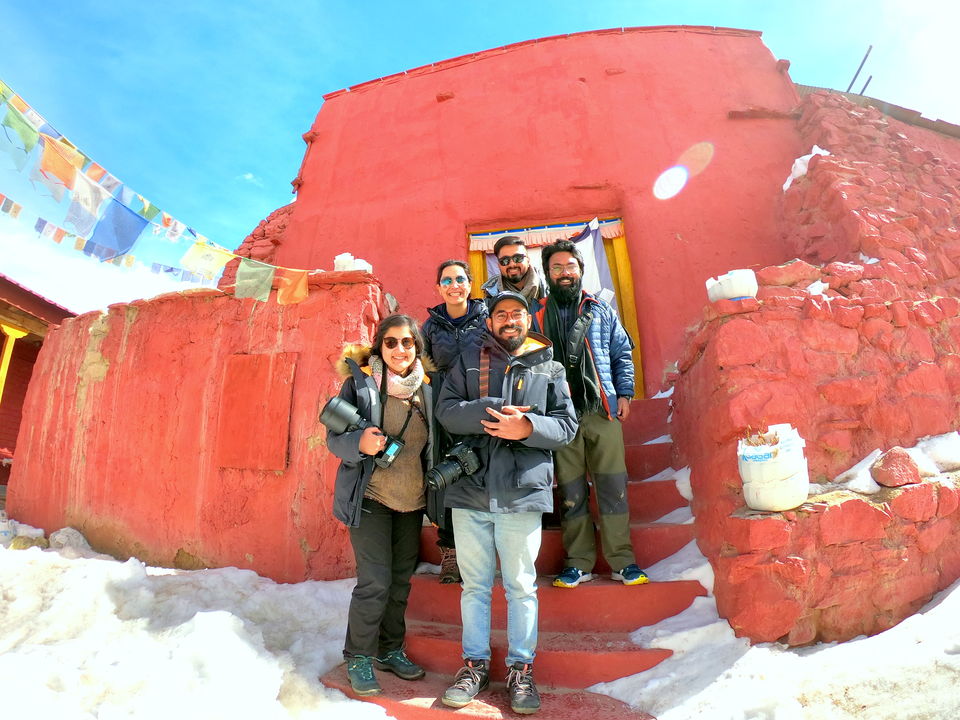
Winter Roadtrip In Spiti Valley: A Detailed Itinerary
Day 1 – Shimla to Rampur (Distance: 126 KM)
Super excited and charged up for the journey ahead, we started at around 8 AM that day. Leaving the hustle & bustle of Shimla behind, we drove past Kufri, Fagu, Theog, Narkanda, and many other villages, tucked on the slopes, away from the chaos & cacophony. It was a lovely sunny day, and the snowclad mountains kept accompanying us throughout, as well as the Sutlej river until we finally reached the Rampur Bushahr, the erstwhile headquarters of Kinnaur District in Himachal.
When we reached our hotel in Rampur, it was already afternoon. We thought to go for a quick tour of the Bhimakali Temple in Sarahan, which was around 38 KM from where we were staying in Rampur. Sarahan is called ‘the Gateway to Kinnaur’, and has one of the oldest settlements on the Indo-Tibetan Road, which dates back to the 15th Century.


Driving down the topsy turvy trails, we finally made it to the temple which is dedicated to the Goddess Bhimakali, the presiding deity of the rulers of former Bushahr State. An architectural marvel, it’s believed to be one of the 51 Shakti Peethas. Around 800 years old, the Bhimakali Temple boasts an architecture that is not duplicated anywhere else and portrays a beautiful blend of Hindu & Buddhist artwork.
Stepping out of the temple, we walked into the nearest restaurant run by Himachal Tourism (which was functional, and we were the only people dining there that afternoon!) and satiated our hunger, before hopping out for a walk around the temple, to get some postcard-perfect photographs. And as the sun started to move closer to the horizon and the temperature dropped, we decided to head back to Rampur.

Day 2 – Rampur to Tabo, via Nako (Distance: 235 KM)
It was 6’O clock in the morning and still dark when we started our journey, shivering in cold. NH 22 that connects Kinnaur District to Spiti Valley is known to be one of the most treacherous roads in the world – and when you’re there, you’d know why! But Angrup Bhaiya was a pro and as we all relaxed, feeling all cozy inside the Tempo Traveler, he smoothly drove down. We stopped at Tapri for a quick breakfast and then continued towards Nako.

As we drove ahead, the terrain slowly started changing its colors and way before Nako, everything was covered in a thick layer of snow. At a distance, we could see the mighty Reo Purgyil, which is known to be the highest mountain in Himachal Pradesh. Located at an altitude of 3,636 meters, Nako is one of the largest villages near the Indo-China border in the Trans-Himalayan region, and it’s famous for the monastery & the sacred lake.
Angrup Bhaiya parked the Traveler inside the Nako Monastery complex, and we all hopped off in happiness, to walk on the snow-laden trails. We weren’t really surprised to see that the monastery was closed, however, we did pose for photographs with the bright red walls of the monastery!
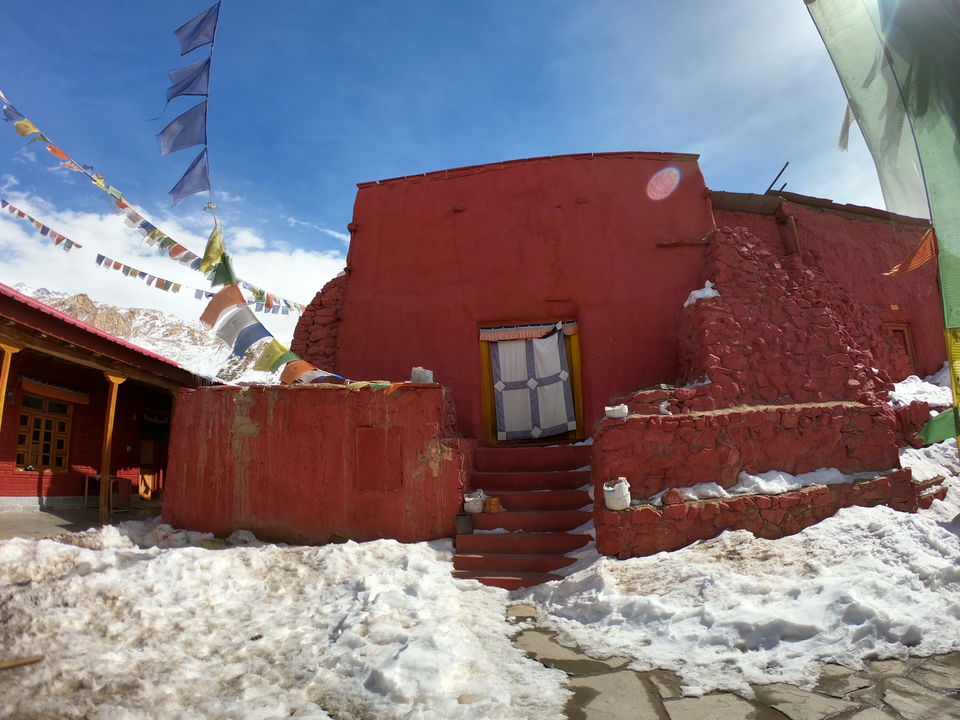
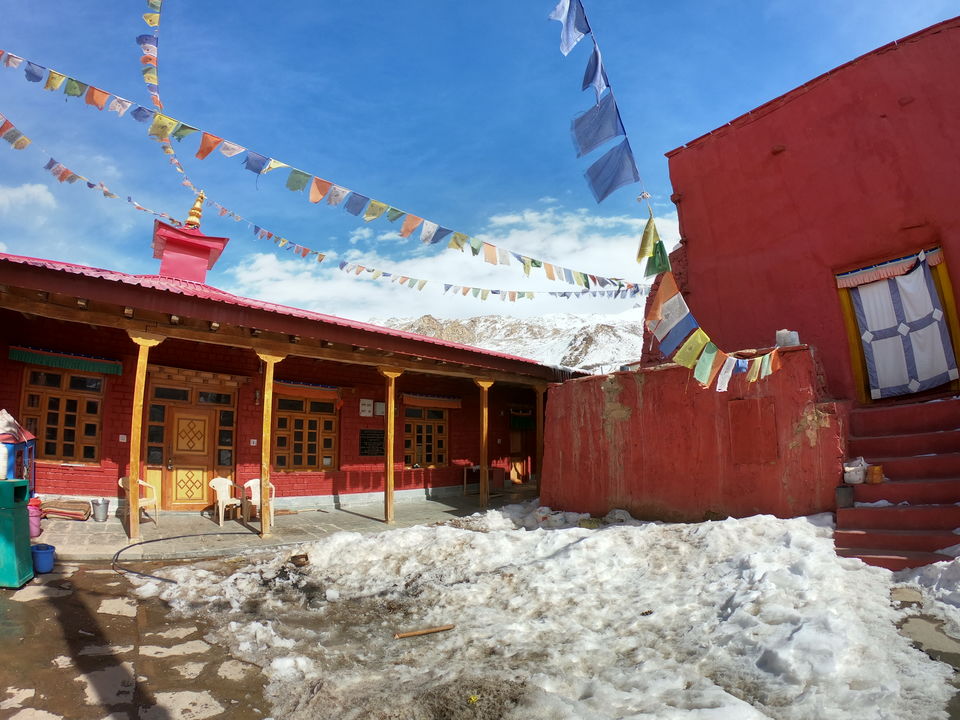

Finding our way to the lake through the village, we were awestruck to see that it was completely FROZEN! Honestly, I’ve never seen a frozen lake, moreover, I had seen Nako Lake in the month of August and now when I looked at it, it felt like someone has cast a spell over it. It took me a minute to soak in the magic that surrounded us right there, at that moment. And as Disha walked ahead, stepping on the ice sheet that covered the lake, I followed her footsteps like a happy child.
We literally crossed the lake walking over it and when we were on the other side, I was drooling over the miracles of nature.
Every nook and corner of Nako looked as if they’re straight out of a storybook! Walking back towards the Traveler, I slipped a few times, lost in thoughts of how I’d seen Nako before & what I was experiencing then.
We had lunch at a tiny shack in Nako and then, continued our journey towards Tabo.
It was late afternoon when we reached Rakesh’s homestay in Tabo and even after traveling for nearly 7 hours, our energy level seemed unaltered. Gulping down cups of seabuckthorn tea, we headed out to explore the caves tucked on a cliff, right opposite to the homestay.


It’s a short hike and as the shades of dusk painted the sky, we sneak peeked into these tiny caves which date back to 1000 years. These caves are apparently meditation areas for monks, who usually spend days here seeking nirvana! From up there, we could see the entire Tabo village, the old and the new monasteries – everything covered in a veil of snow.
Returning back to the homestay, we sat inside Rakesh’s cozy kitchen-cum-dinning space and Sambit narrated us the tales of spotting snow leopards, setting my expectations to the bottom line! Later that evening, we walked into the apple orchard next to the homestay, in pitch darkness. Obviously, our motto was to get some night-sky photographs. (Trust me when I say this, Sambit is super-awesome in clicking those shots, absolutely perfect 🙂 ) Happy with the photoshoot followed by a sumptuous dinner, we retired for the day.

Day 3 – Tabo to Kibber, via Kaza & Key Monastery (Distance: 67 KM)
The plan was to have an early breakfast, explore Tabo Monastery and set out for Kibber. It was a nice, bright day and I draped a saree, battling the chills! As per plans, we binged on the delicious local bread & apple curry cooked by Rakesh, and were off to the monastery.
To add to my surprise again, I was trying to correlate how I had seen Tabo Monastery earlier in August, when it looked barren and yellow. And now, it was all shiny, as the snow reflected the sun rays. Built back in 996 AD, this monastery is over a thousand years old and considered to be the oldest in India. The old monastery has a large hall with beautiful paintings on the walls, which are nearly as old as the monastery itself. We walked around the entire complex, soaking in the sunshine. The new monastery was closed, as all the monks had gone to other places in lower altitude areas.


Bidding ‘goodbye’ to Tabo & Rakesh, we started our journey for Kibber.
Our Tempo Traveler moved on this narrow trail with steep mountains on one side and deep cliffs on the other, the turquoise waters of Spiti River glistening throughout and the adjoining river bank covered with snow. Just before the bridge to Pin Valley, we came across these huge rock structures formed by wind erosion, which resembled a landscape that we see in photographs of Cappadocia! Ankita, who has been to Turkey, agreed that they did look something similar, and we couldn’t hold on to the excitement of getting down to get a closer look at this unique geographical phenomenon!
The name of this place is ‘Lingti’, and the mystical beauty of this hidden Himalayan village is hard to describe.



It was around 1’O clock in the afternoon when we reached Kaza, the capital and regional headquarters of Spiti valley. The otherwise bustling little town was nearly dead this time, and I saw more dogs & cows on the streets than humans! Barely any shop was open in the main market, and most of the restaurants weren’t functioning. We finally managed to get momos and chai at this little shack next to the bus stand.
From Kaza, we had to pick up Dorjee – the main man of this trip! This person, about whom Sambit & Disha had already told us, hopped into the bus with a huge smile on his wrinkled face and it felt like we’ve known him since forever. It didn’t take him much time to gel with us, as he started telling us about snow leopards and red fox. You can call it a stroke of good luck or maybe Dorjee knew some magic, it was just about half an hour since he joined us & on our way to Key Monastery, we spotted a red fox, being chased by a dog!

While the rest of the folks went for a short hike on the snowclad slopes behind Key Monastery, I chose to walk down to the trails that led to the new Buddha installations. Later, we all went up to the monastery, tiptoed inside the prayer halls, had chai offered by the monks and admired the beauty of the adjoining valley.
Located at an altitude of 4,166 meters above sea level, this is the biggest monastery of Spiti Valley and a religious training center for Lamas and the monastery still houses the historic Buddhist scrolls and books representing Tibetan Buddhism. There’s an essence of peace that lingers in the entire vicinity and the white-washed valley just added more charm to it.


Before heading to our homestay in Kibber, we decided to stop at Chicham Bridge (the highest suspension bridge in Asia, connecting two villages – Chicham & Kibber) and see if we could spot some animals. By then, I had already started believing in Dorjee’s magic, as he showed us ibex & blue sheep on the way. No wonders, when we reached Chicham, there were already a couple of foreigners with their cameras & tripods, shooting this red fox which was sitting just next to the roads!
It looked at us, as if it was posing for a photo and then ran over the thick snow layers, disappearing in no time! We were hoping to see snow leopards too, but as they say, all good things shouldn’t happen at one go! We already had had a long day and quite a few adventures. Finally, we reached Zotpa Homestay in Kibber – our den for the next couple of days.

Day 4 – Wildlife Expedition in Kibber
Sounds intimidating, right? Well, we all have an idea that whatever we see in Nat Geo & Animal Planet aren’t shot in a day’s time. It takes a lot of patience and self-motivation to be there in the wilderness, to get that one perfect photograph (or video clip). But the idea only gets real when you’re into it – doing things & experiencing the harsh weather conditions, for the sake of getting a glimpse of the Snow Leopards, or ‘Ghost Cats’ as they are popularly called. To put it in the words of WWF, “The strikingly beautiful snow leopard remains one of the most mysterious cats in the world.”
The temperature was nearly -15 degrees Celcius when we woke up. Having a quick breakfast and packing some snacks to munch for the day, we covered ourselves in as many layers as we could! At around 8’O clock in the morning, we got to know that 2 snow leopards have been spotted & extremely charged up, we headed out from Zotpa Homestay.



About 5 KM from Kibber Village, we reached this place where several other photographs from all across the world had gathered that morning. We had to walk through the snowfield for about half a kilometer and then glide down the slope, to reach the spot from where apparently the snow leopards could be seen. Standing at an edge of the cliff, we heard from others (who have been lucky to reach early and actually saw some movements) that there was one female snow leopard on the other side of the cliff, but she crawled into the rock cave some time back! Dorjee and other guides have been running from one slope to another, crossing that thick snow, to track the wildlife.
The sun was slowly rising higher up & literally burning our exposed skin, while the cold numbed the senses. There were quite a few times when I thought of giving up and heading back to the homestay. But thanks to the immense motivation, Ankita’s stock of oranges, Mrinals’s random jokes and the occasional cups of tea! At one point, I and Disha decided to just take a walk and find a place to pee, but the white stretches seemed more illusive than what we had imagined it to be. In the meanwhile, some ibex and blue sheep were spotted, but nobody was really interested in them that day! Everyone was waiting for the snow leopard to come out from the cave – and I kept doubting my luck!
“Well, who gets to see snow leopards at the first go? And me, who has never had a chance to see anything apart from monkeys and deer in Indian jungles, will get to see snow leopards?” – I was thinking constantly in my mind that all this wait would make no sense at the end of the day. But the enthusiasm amongst my friends was something that I couldn’t help appreciating – even after waiting in that adverse temperature for nearly 5 hours, they had smiles on their faces and hope to see what we had come for.


Post-lunch, when we were chilling and I attempted to make a snowman, suddenly someone informed us that one male snow leopard was seen on another side. It meant going up the cliff for another half a kilometer and then down again, for which I was a bit skeptical! I thought, what if it hides by the time I end up being to that spot – but then, Ankita & Disha has already started climbing up the trail. Mrinal, Rijuman & I followed them.
Camouflaging miraculously, this tiny little animal was soaking in the sun on another side of the mountains, and I could barely see him with my naked eyes. But when I zoomed in through the binoculars, I was stunned. I couldn’t believe that I was seeing one of the rarest animals on Earth and it was just about 200 meters away, not bothered of the humans who had gathered in numbers to see him!

Disha, overjoyed with the sighting, hurriedly tried to go and call Sambit, who was still waiting at the initial spot with his tripod set in order, to click the other snow leopard as she gets out of the cave. And it was finally around 3:30 PM or so, when everyone was beaming with excitement, as 4 snow leopards (a mother & 3 cubs) finally crawled out of their slumber!
There was a sudden adrenalin rush and although I was feeling breathless at times, I tried to pace up and reach the spot from where I could also get to see those folks, sitting with all their glory! It felt like they were looking at us, eye to eye. I had goosebumps, for this was nothing closer to what I had expected to see – but way beyond that. Sometimes, things we see are so surreal that it takes time to sink in – and the same happened with me that day, as I stood on the edge with others, awestruck by the creations of Mother Nature. We were there till sunset, until everyone had taken enough photographs and soothed their eyes with the miraculous views.
On our way back, while the rest of my friends still had the enthusiasm to walk back to Zotpa Homestay, my body started to give up in that cold. Thanks to Dorjee, I managed to get a ride with some other travelers, who were also returning back to Kibber. That evening, sitting around the Bukhara in Lama Tenzing’s house, we couldn’t help but talk about the adventurous day that we had and Sambit re-emphasized how we were now a part of that 1% population in the world who has seen snow leopards!
Day 5 – Exploring Langza, Rangrik & Kaza Monastery
The initial plan was to go for spotting wildlife on this day as well, but we were so overwhelmed by what we had already seen, we chose to chill at the homestay in the morning and then headed off to Langza, the small Spitian village known for its fossil deposits of marine animals and plants that were found here millions of years ago.

Located at an altitude of 14,500 feet above sea level, Langza is popular for the giant Buddha statue overlooking the valley, with a backdrop of the majestic mountains. I’ve been to Langza in the month of August when the mighty mountains were kissed by the floating clouds and I could see the vast stretches of green meadows. That picture of Langza quite vividly existed in my mind, until I was there in February again, and everything was painted white. As they say in Buddhism, everything is impermanent & change is the only constant.
The freezing wind was blowing when we got down at Langza and in no time, we were back in the Tempo Traveler, shivering! Dorjee, by then, had made tea for us 🙂
We had planned to go to Hikkim (the village with the highest altitude post office in the world) and Komic (the highest village in the world connected by motorable roads) but Angrup Bhaiya got to know from the locals that the roads are blocked in those parts of the valley. Hence, we decided to go to Kaza Monastery instead.
Known as Sakya Tangyud Monastery, this is one of the newest monasteries in the valley, portraying vibrant Buddhist architecture that illustrates a beautiful picture of the Sakya sect of Tibetan culture. Colorful paintings highlight the intricate details throughout the elegant structure and an eerie silence welcomed us, as we walked inside.

We had lunch at a shack next to the monastery and headed off to Rangrik, our next stop for the day. Located about 6 km from Kaza across the Spiti River, and connected by a small bridge, Rangrik is said to be one of the largest villages of the valley, with a population of approx 900 people. We didn’t really go into the village but stopped ahead for some photographs. Getting off the Tempo Traveler, all I could see around me was a white world. For a minute, I thought if Narnia looked something similar! As Disha & Sambit took a stroll on the icy trails, Ankita got engrossed in taking some 360-degree photos, Mrinal made a snowball and started kicking it, I plunged into the snow! It was the best thing ever!

Driving down the Winter Wonderland, crossing the Key Monastery all over again, witnessing the gorgeous views of the snow-laden valley, we returned back to the homestay in Kibber.
Day 6 – Kibber to Rampur (Distance: 380 KM approx)
It was time for us to wrap up, pack our things, say goodbye to our hosts in Kibber, and head back to Rampur. A long journey was ahead of us, and we had to start early that day. We dropped Dorjee in Kaza, and as I shook hands with him, in my heart I knew that if it was not him, probably we wouldn’t have had a similar experience. Sambit told us that when BBC had come to Spiti to shoot a documentary on snow leopards, Dorjee was their guide too. Well, it was no less than a privilege for us to be with him on the trip.
We stopped at Hurling for breakfast (about 60 KM from Kibber) and at Spillow for lunch (about 180 KM from Kibber). Slowly, the terrain again changed its colors. By the time we reached Rampur, it was already evening and we were all looking forward to a warm shower after all these days of using dry toilets!

Day 7 – Rampur to Shimla (Distance: 126 KM)
Post-breakfast, we embarked on our journey back to Shimla. Although the trip was on the verge of ending, we still couldn’t stop drooling over our experiences. We were there in Shimla at around 3′ O clock in the afternoon and each one of us was craving for food! Wasting no time, we set out for binging on some momos and apple cider 🙂
Well, all good things need a celebration before coming to an end!
(Check out this Spiti Valley Photo Story)
Things To Remember Before You Go For A Winter Spiti Roadtrip
We understand that you might also be keen to go for this and experience the mystical beauty of Spiti Valley in winter. For the adventurous souls out there, this might turn out to be the best time to visit Spiti, but here are a few things that we would like to share with you.
- You need to be physically fit and have the courage to deal with the extreme cold temperature. Winter in Spiti is harsh and temperatures are known to plummet to lesser than -35 Degree Celcius at night.
- Make sure you don’t have any medical condition before heading to the trip, similar to asthma or any other sickness, which will cause you major damage on the trip.
- Most of the pipelines freeze during this season, and only dry toilets are functional, so be prepared for it.
- Due to unpredictable weather conditions, the roads might get blocked anytime and plans might have to be altered.
- Other than BSNL & Jio, there’s no connectivity in the valley. Even these two might not be operational always. So you should be well aware that getting in touch with people back at home can be an issue.

If you've been thinking of exploring Spiti during the winters, you must go for it - for the winter wonderland won't disappoint you at all.
This article was originally published on RoyTellsTales.
Think we missed out on something? Tell us about it in the comments below. Or write about it here on Tripoto.













